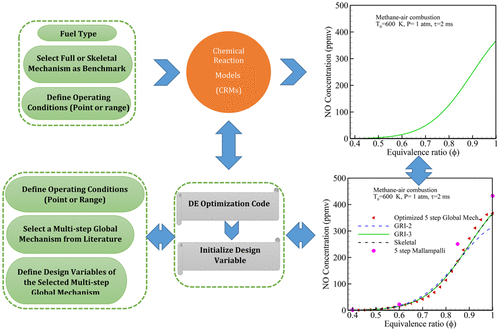当前位置:
X-MOL 学术
›
Ind. Eng. Chem. Res.
›
论文详情
Our official English website, www.x-mol.net, welcomes your feedback! (Note: you will need to create a separate account there.)
Integrated Procedure, Using Differential Evolution Optimization of Rate Parameters, for Design of Small and Accurate Multistep Global Chemical Mechanisms
Industrial & Engineering Chemistry Research ( IF 4.2 ) Pub Date : 2018-03-01 00:00:00 , DOI: 10.1021/acs.iecr.8b00144 Alireza Shakeri 1 , Karim Mazaheri 1
Industrial & Engineering Chemistry Research ( IF 4.2 ) Pub Date : 2018-03-01 00:00:00 , DOI: 10.1021/acs.iecr.8b00144 Alireza Shakeri 1 , Karim Mazaheri 1
Affiliation

|
Three-dimensional analysis of combustion chambers in industrial gas turbines suffers from lack of simple and accurate reduced mechanisms for oxidation of hydrocarbon fuels. Here, an integrated procedure is introduced based on a differential evolution optimization technique. The procedure is flexible and modular and allows optimization of many rate parameters of a multistep global mechanism based on many different combustion criteria and inlet or operational conditions. The procedure uses any selected chemical reactor model and any reference combustion mechanism provided. Sample design criteria used here are flame temperature, ignition delay time, and concentration of selected species, especially pollutants. Different low atmospheric pressures and high pressure combustion conditions are considered. Reactor models used here are zero and one-dimensional reactors of PSR, PFR, IGNITION, and PREMIX models. To show applicability and performance of the procedure, the algorithm is analyzed in detail during four different case studies. The first two cases consider application to methane, using a five-step global mechanism. Case 3 considers application of a 3-sep mechanism for simulation of propane oxidation, and finally kerosene oxidation via a 3-step mechanism to predict its transient behavior is studied in case 4. Many global, temporal and spatial combustion properties are studied, and it is shown that for most off-design conditions studied here, the relative error of the most significant performance parameters is below one percent.
中文翻译:

集成程序,使用速率参数的微分演化优化,设计小而精确的多步全局化学机制
工业燃气轮机中燃烧室的三维分析缺乏用于烃类燃料氧化的简单而准确的还原机制。在这里,介绍了一种基于差分进化优化技术的集成过程。该过程是灵活的和模块化的,并允许基于许多不同的燃烧标准和进气或运行条件来优化多步全局机构的许多速率参数。该程序使用任何选定的化学反应堆模型和提供的任何参考燃烧机理。这里使用的样本设计标准是火焰温度,点火延迟时间和所选物质(尤其是污染物)的浓度。考虑了不同的低气压和高压燃烧条件。这里使用的电抗器模型是PSR,PFR,IGNITION和PREMIX模型的零维和一维电抗器。为了显示该程序的适用性和性能,在四个不同的案例研究中对该算法进行了详细分析。前两种情况使用五步全局机制考虑将其应用于甲烷。案例3考虑了应用3 sep机理模拟丙烷氧化,最后在案例4中研究了通过3步机理预测煤油的瞬态行为的煤油氧化,研究了许多全局,时间和空间燃烧特性,并对其进行了研究。结果表明,对于此处研究的大多数非设计条件,最重要的性能参数的相对误差都小于1%。在四个不同的案例研究中对该算法进行了详细分析。前两种情况使用五步全局机制考虑将其应用于甲烷。案例3考虑了应用3 sep机理模拟丙烷氧化,最后在案例4中研究了通过3步机理预测煤油的瞬态行为的煤油氧化,研究了许多全局,时间和空间燃烧特性,并对其进行了研究。结果表明,对于此处研究的大多数非设计条件,最重要的性能参数的相对误差都小于1%。在四个不同的案例研究中对该算法进行了详细分析。前两种情况使用五步全局机制考虑将其应用于甲烷。案例3考虑了应用3 sep机理模拟丙烷氧化,最后在案例4中研究了通过3步机理预测煤油的瞬态行为的煤油氧化,研究了许多全局,时间和空间燃烧特性,并对其进行了研究。结果表明,对于此处研究的大多数非设计条件,最重要的性能参数的相对误差都小于1%。
更新日期:2018-03-02
中文翻译:

集成程序,使用速率参数的微分演化优化,设计小而精确的多步全局化学机制
工业燃气轮机中燃烧室的三维分析缺乏用于烃类燃料氧化的简单而准确的还原机制。在这里,介绍了一种基于差分进化优化技术的集成过程。该过程是灵活的和模块化的,并允许基于许多不同的燃烧标准和进气或运行条件来优化多步全局机构的许多速率参数。该程序使用任何选定的化学反应堆模型和提供的任何参考燃烧机理。这里使用的样本设计标准是火焰温度,点火延迟时间和所选物质(尤其是污染物)的浓度。考虑了不同的低气压和高压燃烧条件。这里使用的电抗器模型是PSR,PFR,IGNITION和PREMIX模型的零维和一维电抗器。为了显示该程序的适用性和性能,在四个不同的案例研究中对该算法进行了详细分析。前两种情况使用五步全局机制考虑将其应用于甲烷。案例3考虑了应用3 sep机理模拟丙烷氧化,最后在案例4中研究了通过3步机理预测煤油的瞬态行为的煤油氧化,研究了许多全局,时间和空间燃烧特性,并对其进行了研究。结果表明,对于此处研究的大多数非设计条件,最重要的性能参数的相对误差都小于1%。在四个不同的案例研究中对该算法进行了详细分析。前两种情况使用五步全局机制考虑将其应用于甲烷。案例3考虑了应用3 sep机理模拟丙烷氧化,最后在案例4中研究了通过3步机理预测煤油的瞬态行为的煤油氧化,研究了许多全局,时间和空间燃烧特性,并对其进行了研究。结果表明,对于此处研究的大多数非设计条件,最重要的性能参数的相对误差都小于1%。在四个不同的案例研究中对该算法进行了详细分析。前两种情况使用五步全局机制考虑将其应用于甲烷。案例3考虑了应用3 sep机理模拟丙烷氧化,最后在案例4中研究了通过3步机理预测煤油的瞬态行为的煤油氧化,研究了许多全局,时间和空间燃烧特性,并对其进行了研究。结果表明,对于此处研究的大多数非设计条件,最重要的性能参数的相对误差都小于1%。



























 京公网安备 11010802027423号
京公网安备 11010802027423号